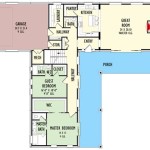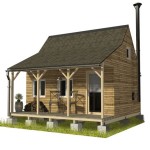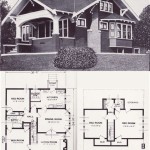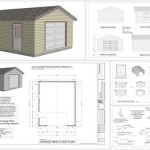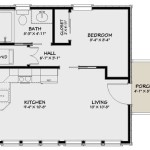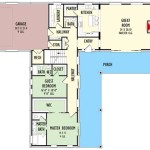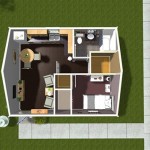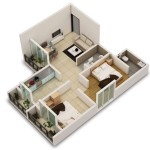L-Shaped House Floor Plans: Design, Benefits, and Considerations
L-shaped house floor plans represent a versatile and adaptable architectural design that has been favored for centuries. This design, characterized by its two wings forming an "L" shape, offers numerous advantages in terms of space utilization, natural light maximization, and privacy zoning. Understanding the nuances of this floor plan configuration is crucial for prospective homeowners, builders, and architects seeking to optimize living spaces and create aesthetically pleasing and functional residences.
Space Optimization and Flexibility
One of the primary benefits of an L-shaped house floor plan is its inherent ability to optimize space utilization. The "L" configuration naturally creates distinct zones within the home, allowing for a clear separation between public and private areas. For example, one wing of the "L" might house the living room, dining room, and kitchen, forming the central hub for family activities and social gatherings. The other wing can then be designated for bedrooms, bathrooms, and home offices, providing a quieter and more secluded environment. This spatial division is particularly advantageous for families with diverse needs and schedules, enabling simultaneous activities without undue disruption.
Furthermore, the L-shape lends itself well to open-concept designs. The intersection of the two wings can be strategically utilized to create a large, open living area that seamlessly integrates the kitchen, dining, and living spaces. This arrangement promotes a sense of spaciousness and encourages social interaction. The flexibility of the design also allows for easy adaptation to different lot shapes and orientations. The wings can be adjusted in length and angle to maximize views, capture sunlight, and accommodate site-specific constraints.
The exterior space created by the "L" shape provides an ideal setting for outdoor living. This area can be transformed into a private courtyard, patio, or garden, extending the living space outdoors and creating a seamless connection between the interior and exterior. The courtyard can be particularly useful in providing a sheltered and secluded outdoor area, protected from wind, noise, and unwanted views.
The adaptability of the L-shaped design extends to future modifications and additions. The wings can be easily extended or adapted to accommodate changing needs and preferences. For example, a growing family might add an additional bedroom to one wing, or a homeowner might decide to convert a portion of the living area into a home office. This flexibility makes the L-shaped house a sustainable and long-term housing solution.
Natural Light and Ventilation
The L-shaped configuration offers significant advantages in maximizing natural light and ventilation. The two wings of the house provide increased surface area for windows, allowing sunlight to penetrate deep into the interior spaces. This not only reduces the need for artificial lighting but also creates a brighter and more cheerful living environment. The strategic placement of windows can also capture prevailing breezes, promoting natural ventilation and reducing reliance on air conditioning.
The orientation of the L-shaped house is crucial for optimizing solar gain. In colder climates, orienting the longer wing of the "L" towards the south can maximize sunlight exposure during the winter months, helping to warm the home and reduce heating costs. In warmer climates, orienting the longer wing east-west can minimize direct sunlight exposure during the hottest part of the day, helping to keep the home cool and reduce cooling costs. The careful consideration of solar orientation can significantly impact the energy efficiency and comfort of the house.
The courtyard or outdoor space created by the "L" shape also plays a role in natural light and ventilation. The open space allows sunlight to reflect into the interior rooms, further enhancing the brightness of the living areas. The open space also facilitates natural ventilation, allowing air to circulate freely around the house. In warmer climates, a well-designed courtyard can create a cooling microclimate, reducing the need for air conditioning.
Skylights are another valuable tool for maximizing natural light in an L-shaped house. Skylights can be strategically placed in areas that receive limited natural light from windows, such as hallways or bathrooms. Skylights can also be used to highlight architectural features or to create a dramatic lighting effect. When designing an L-shaped house, it is important to consider the placement of windows and skylights to optimize natural light and ventilation and create a comfortable and energy-efficient living environment.
Privacy and Zoning
L-shaped house floor plans are well-suited for creating distinct zones and enhancing privacy within the home. The separation of the two wings allows for a clear division between public and private areas, as previously mentioned. This zoning is particularly beneficial for families with diverse needs and schedules, allowing for simultaneous activities without undue disruption. For example, while one family member is entertaining guests in the living room, another family member can enjoy quiet time in the bedroom wing.
The L-shape also provides opportunities for creating private outdoor spaces. The courtyard or patio formed by the "L" can be shielded from street views and neighboring properties, creating a secluded and tranquil outdoor retreat. This is particularly valuable in urban or suburban settings where privacy is at a premium. The courtyard can be further enhanced with landscaping, fencing, or other screening elements to create a truly private oasis.
The arrangement of rooms within each wing can also contribute to privacy. For example, bedrooms can be clustered together at the end of one wing, away from the main living areas. Bathrooms can be located between bedrooms to provide sound insulation and minimize noise transmission. Home offices can be located in a separate wing or at the end of a wing to provide a quiet and distraction-free work environment.
The entrance to the house can also be strategically located to enhance privacy. The entrance can be placed on the outside of the "L," away from the main living areas, to create a buffer zone between the public and private realms. A well-designed entryway can also provide a sense of security and privacy, making visitors feel welcome while still maintaining the privacy of the home.
The design also lends itself to multi-generational living. One wing can be designed as a self-contained suite for elderly parents or adult children, providing them with privacy and independence while still allowing them to be close to family. This arrangement can be particularly beneficial for families who want to provide care for their aging parents or support their adult children as they transition into independence.
The L-shaped floor plan offers a blend of open living spaces and private retreats, creating a comfortable and functional home that can adapt to the evolving needs of its occupants. The strategic use of zoning, landscaping, and architectural elements can enhance privacy and create a sense of tranquility within the home.
When considering an L-shaped house floor plan, it's important to factor in the specific needs and preferences of the occupants, as well as the characteristics of the building site. The orientation, size, and location of the wings should be carefully considered to maximize space utilization, natural light, ventilation, and privacy. Working with an experienced architect or designer can help to ensure that the L-shaped house is tailored to meet the unique needs and aspirations of the homeowners and to create a truly exceptional living environment.
Careful consideration of the interior design is also crucial. The open-concept nature of many L-shaped houses requires a cohesive design aesthetic to unify the different living spaces. The use of consistent colors, materials, and furnishings can help to create a harmonious and inviting atmosphere. The interior design should also reflect the lifestyle and personality of the homeowners, creating a space that is both functional and aesthetically pleasing.
Finally, it is important to consider the cost implications of an L-shaped house floor plan. While the design offers numerous advantages, it may also be more expensive to build than a simple rectangular house due to the increased perimeter and complexity of the construction. However, the long-term benefits of an L-shaped house, such as energy efficiency, flexibility, and enhanced living space, may outweigh the initial cost considerations. A thorough cost-benefit analysis can help to determine whether an L-shaped house is the right choice for a particular project.

53 Best L Shaped House Plans Ideas

Best 25 L Shaped House Plans Ideas On Bungalow Floor Ranch Style

Plan 531 2 L Shaped House Plans U

L Shaped House Plan With Upstairs Family Room Kitchenette And Home Office 777053mtl Architectural Designs Plans

Why An L Shaped House Plan Makes The Best Home Design Monster Plans Blog

Practical 2 Bedroom House Plan With L Shaped Kitchen

L Shaped House Plan

L Shape Shaped House Plans One Bedroom

L Shaped House Plans With Side Garages Blog Eplans Com

Small Simple L Shaped With Floor Plan Full Tour

